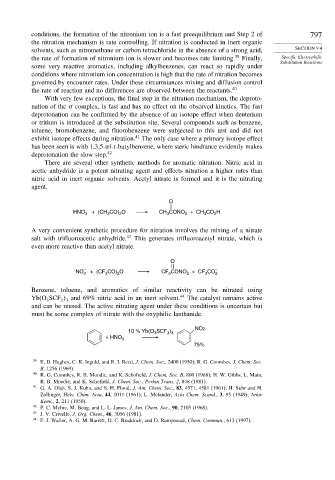Page 814 - Advanced Organic Chemistry Part A - Structure and Mechanisms, 5th ed (2007) - Carey _ Sundberg
P. 814
conditions, the formation of the nitronium ion is a fast preequilibrium and Step 2 of 797
the nitration mechanism is rate controlling. If nitration is conducted in inert organic
solvents, such as nitromethane or carbon tetrachloride in the absence of a strong acid, SECTION 9.4
the rate of formation of nitronium ion is slower and becomes rate limiting. 39 Finally, Specific Electrophilic
Substitution Reactions
some very reactive aromatics, including alkylbenzenes, can react so rapidly under
conditions where nitronium ion concentration is high that the rate of nitration becomes
governed by encounter rates. Under these circumstances mixing and diffusion control
the rate of reaction and no differences are observed between the reactants. 40
With very few exceptions, the final step in the nitration mechanism, the deproto-
nation of the complex, is fast and has no effect on the observed kinetics. The fast
deprotonation can be confirmed by the absence of an isotope effect when deuterium
or tritium is introduced at the substitution site. Several compounds such as benzene,
toluene, bromobenzene, and fluorobenzene were subjected to this test and did not
41
exhibit isotope effects during nitration. The only case where a primary isotope effect
has been seen is with 1,3,5-tri-t-butylbenzene, where steric hindrance evidently makes
deprotonation the slow step. 42
There are several other synthetic methods for aromatic nitration. Nitric acid in
acetic anhydride is a potent nitrating agent and effects nitration a higher rates than
nitric acid in inert organic solvents. Acetyl nitrate is formed and it is the nitrating
agent.
O
HNO + (CH CO) O CH CONO + CH CO H
3
3
3
2
2
2
3
A very convenient synthetic procedure for nitration involves the mixing of a nitrate
salt with trifluoroacetic anhydride. 43 This generates trifluoroacetyl nitrate, which is
even more reactive than acetyl nitrate.
O
– –
NO + (CF CO) O CF CONO + CF CO 2
3
2
3
3
2
3
Benzene, toluene, and aromatics of similar reactivity can be nitrated using
Yb(O SCF and 69% nitric acid in an inert solvent. 44 The catalyst remains active
3 3
3
and can be reused. The active nitrating agent under these conditions is uncertain but
must be some complex of nitrate with the oxyphilic lanthanide.
NO2
10 % Yb(O SCF )
3
3 3
+ HNO 3
75%
39
E. D. Hughes, C. K. Ingold, and R. I. Reed, J. Chem. Soc., 2400 (1950); R. G. Coombes, J. Chem. Soc.
B, 1256 (1969).
40 R. G. Coombes, R. B. Moodie, and K. Schofield, J. Chem. Soc. B, 800 (1968); H. W. Gibbs, L. Main,
R. B. Moodie, and K. Schofield, J. Chem. Soc., Perkin Trans. 2, 848 (1981).
41 G. A. Olah, S. J. Kuhn, and S. H. Flood, J. Am. Chem. Soc., 83, 4571, 4581 (1961); H. Suhr and H.
Zollinger, Helv. Chim. Acta, 44, 1011 (1961); L. Melander, Acta Chem. Scand., 3, 95 (1949); Arkiv
Kemi., 2, 211 (1950).
42
P. C. Myhre, M. Beug, and L. L. James, J. Am. Chem. Soc., 90, 2105 (1968).
43 J. V. Crivello, J. Org. Chem., 46, 3056 (1981).
44
F. J. Waller, A. G. M. Barrett, D. C. Braddock, and D. Ramprasad, Chem. Commun., 613 (1997).

